10 Green Remodeling Tips for an Eco-Friendly Home


“More and more homeowners are thinking of “legacy homes” – homes they leave to family members. In those cases, they can see it as a good thing to leave homes that have “green” products. Sustainable products can help homeowners get out of the ever increasing expense of maintenance.”
Todd E. Miller | Isaiah Industries
So how do you make a green home happen? Well, we spoke to the experts to find out.
Green Remodeling Tips
A shift is taking place in the home building and remodeling industry. Green home renovations, long thought of as too expensive or complex, are more affordable and achievable than ever.
At the same time, homeowners are increasingly concerned with their impact on the environment. That’s why words like energy-efficient, sustainable and recyclable are becoming central to the homebuilding process. On top of that, increasing labor and material costs have a new generation of homebuyers rethinking the entire building and renovation process.
10 Green Remodeling Tips for the Home
1. Complete an Energy Audit
Before digging into any major green home renovations, it’s important to know how your home is performing currently. Window and door leaks, outdated appliances and inefficient HVAC systems don’t exactly equate to an efficient, eco-friendly home. Knowing the root of the problem is the first step in completing a green remodel.

“Every remodel should start with an energy audit — these are incredibly helpful in-home tutorials on how your house uses (and wastes) energy. Often they are heavily subsidized by energy companies and will give you free light bulbs, water saving devices, even programmable thermostats and install them for free.”
Susannah Shmurak | HealthyGreenSavvy
Many homeowners end up shocked at how much energy (and money) their home is wasting. Trained professionals can show you exactly where your house is leaking energy or air and provide solutions for problem spots.
To find a certified energy rater for a home energy audit, the U.S. Department of Energy recommends using the Residential Energy Service Network directory. You can also do a DIY energy audit on your own.
DIY Home Energy Audit Checklist:
- Check doors and windows for drafts.
- Inspect HVAC and ventilation systems.
- Use an electricity monitor to find out how much energy your appliances are using.
- Replace older lightbulbs with CFLs, LEDs or eco-incandescent bulbs.
- Examine your home’s insulation, in both the attic and walls.
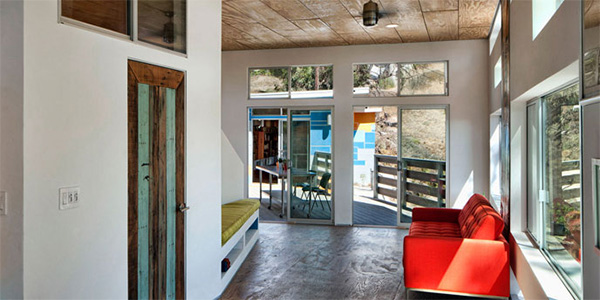
2. Upgrade to Eco-Friendly Windows
Drafty windows are the bane of eco-friendly homes. If yours are taking a toll on your heating and air usage, it may be time to upgrade to more modern, energy-efficient windows.
Using materials that are sustainably sourced is also important for a successful green home remodeling job. For instance, cellular PVC is a popular, energy-efficient window material, but it is produced using a process that releases toxins into the earth’s atmosphere. Here are a few green remodeling tips for purchasing responsibly produced windows.
Tips for Buying Eco-Friendly Windows:
- Aluminum and steel are recyclable but offer little insulation, making them inefficient.
- Vinyl, like PVC, is made using a toxic, highly inefficient production process.
- Double and triple-pane glass cost more, but will insulate your home better.
- Sustainably-harvested wooden frames are a good choice for eco-friendly windows.
- Fiberglass window frames are made from sand, a virtually limitless resource.
3. Choose Locally Sourced Materials
Choosing an eco-friendly product is great, but if it has to be shipped across the country, it’s hard to say it’s truly green. Buying locally sourced materials requires far less energy to get the products to your door. Additionally, local professionals are a valuable resource, as their knowledge of nearby communities, the types of homes in the area and even the local climate can be very useful to you and your project.

“Use materials that are locally sourced and fit your home. What works in Phoenix often won’t in Philadelphia, but it can also vary from home to home. The solution for a newer suburban home might not be right for a century old rowhome. The right green materials and design ideas will bring your house up to date while respecting its history.”
Kenny Grono | Buckminster Green
Beyond supporting small businesses, going local also enables you to choose climate-appropriate materials, making your home more energy-efficient overall.

4. Switch to Low VOC Paints
Volatile organic compounds, or “VOCs,” are chemicals that evaporate and enter the air at ordinary room temperatures, and they are common in many paints. The VOCs in interior paint come from petroleum-based solvents used in their production.
Low VOC interior paints use water in place of these solvents. Using no or low VOC interior paints lowers the amount of harmful emissions in your home, while also minimizing your consumption of petroleum, a non-renewable resource, making this a great project to add to your list of eco-friendly home improvements.
Best Low VOC Paints for a Green Home Remodel:
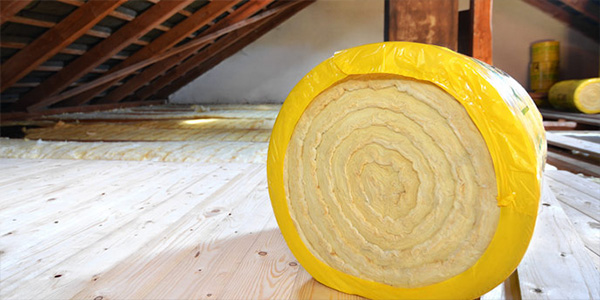
5. Insulate Your Home
Wall cavities – the insulated spaces between an inner and outer wall of your home – are often overlooked during green home remodeling projects. However, they can make or break your home’s efficiency. Luckily, there are green solutions that are both inexpensive and effective.
Blowing cellulose is a quick fix since it can often be blown over insulation that’s already there. On top of that, many states offer rebate programs for completing this eco-friendly renovation project. Here’s a thorough guide on picking insulation for your home.
Want to dig deeper into the green building industry? Here's how it's helping create a more sustainable future!
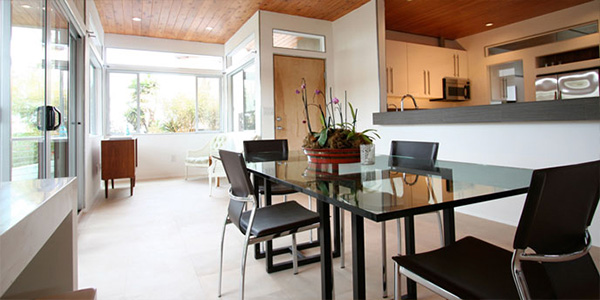
6. Go for a Passive Solar Home Design
Going solar is a great green remodeling project, but you can harness the power of the sun without dropping your entire budget on new solar panels. Passive solar home design is the art of using the sun to your advantage, allowing it to warm your home in the winter while blocking it out in the summer. You’ll be surprised at what a difference some simple changes can make.

“Consider how the sun’s energy can positively and negatively affect your home. Plant deciduous plants and trees that can shade your home in the summer, but allow the sun to warm your home in the winter. Install shades or blinds that can reduce direct sunlight while the air-conditioning is running and allow it when the heat is running.”
Ed Roskowinski | Vujovich Design Build
Green Home Renovations for Passive Solar Home Design:
- Focus renovations on the sides of your home that receive the most sun.
- Plant seasonal trees that block sunlight in the summer, but allow it in during the winter.
- Choose smart blinds that open and close with light and temperature changes.
- Install a solar chimney to improve your home’s heating and ventilation.
- Apply heat reducing film to your windows.
- Add eave overhangs or awnings to block direct sunlight from reaching your windows.
And if you’re ever looking for that final push from passive solar to the real thing, remember that “panels will start paying YOU money in under 10 years,” according to Roskowinski.
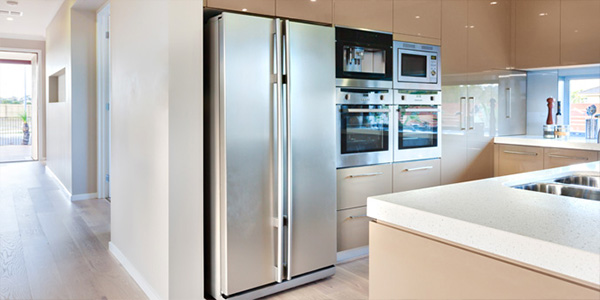
7. Replace Old Appliances
Spending thousands on a new fridge may not be the most cost-effective green remodeling tip, so this tip really depends on your budget and how important new appliances are to you. Either way, it’s important to keep in mind that older appliances were built without efficiency in mind. That means your refrigerator, stove, dishwasher and washer/dryer could be sucking up excess energy by the minute.
ENERGY STAR provides a great list of resources for checking how much money and energy appliances with their certification can save you. You can also take advantage of rebate programs to get additional dollars back.
Ready to move forward with your remodeling plans? Here's how to plan a home renovation from start to finish!
8. Install a Smart Home Thermostat
One of the best and most popular green remodeling tips today is to install a smart home thermostat. Smart home thermostats can be connected to most electronic devices and controlled from afar, which allows you to adjust your home’s heating and cooling even when you aren’t there.
Some thermostats can even detect when you’ve left the house and adjust the temperature on their own. Installing a smart home thermostat is a great way to cut down your energy bill and increase your home’s efficiency.
Best Smart Home Thermostats for a Green Remodel:
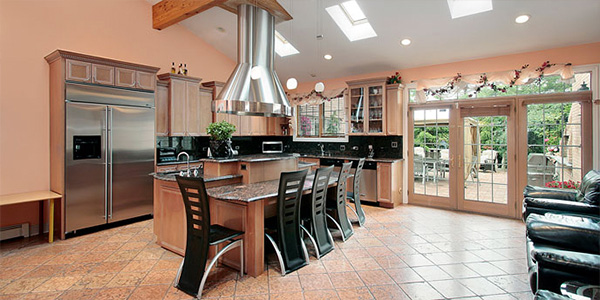
9. Add Skylights to Increase Natural Light
If you hate the idea of using lamps in the middle of the day, try adding skylights to light your home naturally. While it might not be cost-effective to install them in every room, you can strategically place skylights in the most commonly used areas during the day, such as the kitchen, living room or guest bathroom. Remember to fit your skylights with automated blinds to block the sun when needed. Used correctly, skylights can be a great eco-friendly remodeling project for your home and help cut down on your overall electricity use.
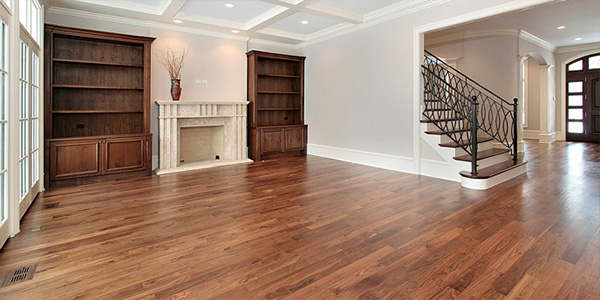
10. Use Responsibly-Sourced Hardwood Products
Hardwood panels and flooring are among the greenest wood product options available, provided you choose responsibly sourced wood. One way to do this is to use FSC Certified wood. The Forest Stewardship Council, or FSC, is dedicated to ensuring that their members market only sustainably harvested and produced hardwood products. By using businesses that sell FSC Certified wood, you’re supporting efforts to keep our forests green and plentiful.
We asked Columbia Forest Products, a provider of FSC Certified products, for advice on buying responsibly forested hardwood flooring, cabinetry and furniture:

“A great deal of wood products are now imported, so always use care in selection and sourcing. For engineered wood, as used in furniture, cabinets and flooring, look for CARB and TSCA compliant labeling, which provides assurance related to formaldehyde gassing. Look to building standards like Well or The Living Building Challenge for inspiration on blending appropriate products with pleasing design. Lastly, a good finish that is low-emitting is important.”
Paul Davis | Columbia Forest Products
FSC Certified Hardwood Material Suppliers for a Green Home Remodel:
- Columbia Forest Products
- Northland Forest Products
- American Pole & Timber
- Certified Wood Products
- US Floors
Additionally, Home Depot makes an effort to stock FSC Certified products – call your local store to see what options they have available. For a full list of FSC Certified Wood providers, check the Forest Stewardship Council’s Member List.



